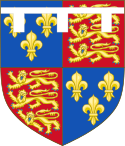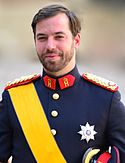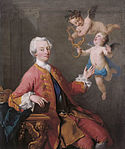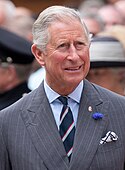Prince de Galles
Pour les articles homonymes, voir Prince de Galles (homonymie) et Galles (homonymie).
| Prince de Galles Prince of Wales |
||
 Armoiries du prince de Galles. |
||
|
|
||
 Titulaire actuel William de Galles depuis le (6 jours) |
||
|
|
||
| Création | 1301 | |
|---|---|---|
| Premier titulaire | Dafydd ap Llywelyn | |
| Résidence officielle |
Palais de Kensington (Londres) Anmer Hall (Norfolk) Adelaide Cottage (Berkshire, Windsor) |
|
| Site internet | http://www.princeofwales.gov.uk | |
| modifier |
||
Le titre de prince de Galles (en anglais : Prince of Wales, en gallois : Tywysog Cymru) est traditionnellement attribué au fils aîné et héritier du monarque du Royaume-Uni. Le titre de comte de Chester est attaché à celui de prince de Galles depuis le XIVe siècle. Les regalia du prince de Galles sont connus sous le nom « d'honneurs de la principauté de Galles ».
Le titulaire actuel est le prince William depuis le , nommé par son père le roi Charles III[1].
Histoire du titre
Édouard II reçut le premier en 1301 de son père Édouard Ier le titre de prince de Galles, pays que ce dernier venait de conquérir. Le titre est octroyé à la fin de la campagne qu'Édouard Ier mène contre les Gallois. Le roi fit édifier une forteresse à Caernarfon face aux monts Snowdon, où il installa sa femme, la reine Aliénor de Castille. Elle y mit au monde un fils (sur les seize enfants qu'elle eut du roi). La campagne terminée, le roi proposa aux Gallois la paix et un prince : ceux-ci réclamèrent un prince né dans la principauté, ne parlant ni français ni anglo-saxon, croyant ainsi mettre le roi dans l'embarras. Alors le roi leur présenta son nouveau-né, et les rudes Gallois vinrent baiser la main de la reine et de l'enfant, devenu prince de Galles. Le titre a donc été accepté à cause de son épouse française, le suivant sur les champs de bataille[2].
En 1346, Jean l'Aveugle tombe à la bataille de Crécy à laquelle il participait du côté du roi de France. Son cimier consistant d'un grand vol (deux grandes ailes d'oiseau) ayant été saisi par Édouard de Woodstock, il serait devenu le cimier, puis l'insigne de cette principauté, de même que sa devise Ich Dien (« Je sers »).
Avant la conquête anglaise, rares étaient les seigneurs locaux qui s'intitulaient « prince de Galles » ; en effet, après l'occupation romaine, le pays s'était divisé en petites principautés concurrentes. Néanmoins, Dafydd ap Llywelyn fut reconnu prince de Galles par le roi Henri III d'Angleterre. Son neveu Llywelyn ap Gruffydd, prince de Gwynedd et dernier souverain gallois, réclama lui aussi le titre en 1258. De 1400 à environ 1412, Owain Glyndŵr établit une principauté indépendante de Galles dont il fut le souverain, le dernier Gallois à porter le titre de « prince de Galles ».
La cérémonie d'investiture du Prince de Galles se déroula au château de Caernarfon pour la première fois en 1911 pour le fils aîné du roi George V, le futur Édouard VIII. Cette cérémonie fut répétée en 1969 pour l'investiture de Charles, fils de la reine Élisabeth II.
Liste des princes de Galles
Plantagenêts (1301-1485)
Branche directe (1301-1399)
| Portrait | Nom | Monarque | Parenté avec le monarque | Naissance | Devient héritier | Créé prince de Galles | Investiture | Cesse d'être prince de Galles | Mort | Armoiries |
|---|---|---|---|---|---|---|---|---|---|---|

|
Édouard de Carnarvon futur Édouard II |
Édouard Ier | fils | 25 avril 1284 | 19 août 1284 | 7 février 1301[3] | 7 juillet 1307 accède au trône |
21 septembre 1327 (présumé) |

|
|
|
|
Édouard de Woodstock | Édouard III | fils | 15 juin 1330 | 12 mai 1343[3] | 8 juin 1376 |

|
|||

|
Richard de Bordeaux futur Richard II |
petit-fils | 6 janvier 1367 | 8 juin 1376 | 20 novembre 1376[3] | 21 juin 1377 accède au trône |
14 février 1400 |

|
||
Maison de Lancastre (1399-1461, 1470-1471)
| Portrait | Nom | Monarque | Parenté avec le monarque | Naissance | Devient héritier | Créé prince de Galles | Investiture | Cesse d'être prince de Galles | Mort | Armoiries |
|---|---|---|---|---|---|---|---|---|---|---|

|
Henri de Monmouth futur Henri V |
Henri IV | fils | 16 septembre 1386 | 30 septembre 1399 | 15 octobre 1399[3] | 20 mars 1413 accède au trône |
31 août 1422 |

|
|

|
Édouard de Westminster | Henri VI | fils | 13 octobre 1453 | 15 mars 1454[3] | 9 juin 1454 | 4 mai 1471 |

|
||
Maison d'York (1471-1485)
| Portrait | Nom | Monarque | Parenté avec le monarque | Naissance | Devient héritier | Créé prince de Galles | Investiture | Cesse d'être prince de Galles | Mort | Armoiries |
|---|---|---|---|---|---|---|---|---|---|---|

|
Édouard futur Édouard V |
Édouard IV | fils | 2 novembre 1470 | 11 avril 1471 | 26 juin 1471[3] | 18 avril 1475 | 9 avril 1483 accède au trône |
septembre 1483 (présumé) |

|

|
Édouard de Middleham | Richard III | fils | vers décembre 1473 | 26 juin 1483 | 24 août 1483[3] | 8 septembre 1483 | 9 avril 1484 |

|
|
Maison Tudor (1485-1603)
| Portrait | Nom | Monarque | Parenté avec le monarque | Naissance | Devient héritier | Créé prince de Galles | Investiture | Cesse d'être prince de Galles | Mort | Armoiries |
|---|---|---|---|---|---|---|---|---|---|---|

|
Arthur Tudor | Henri VII | fils | 20 septembre 1486 | 29 novembre 1489[3] | 27 février 1490 | 2 avril 1502 |

|
||

|
Henri Tudor futur Henri VIII |
fils | 28 juin 1491 | 2 avril 1502 | 18 février 1504[3] | / | 21 avril 1509 accède au trône |
28 janvier 1547 |

|
|
Maison Stuart (1603-1649, 1660-1714)
| Portrait | Nom | Monarque | Parenté avec le monarque | Naissance | Devient héritier | Créé prince de Galles | Investiture | Cesse d'être prince de Galles | Mort | Armoiries |
|---|---|---|---|---|---|---|---|---|---|---|

|
Henri-Frédéric Stuart | Jacques Ier | fils | 19 février 1594 | 24 mars 1603 | 4 juin 1610[3] | / | 6 novembre 1612 |

|
|

|
Charles Stuart futur Charles Ier |
fils | 19 novembre 1600 | 6 novembre 1612 | 4 novembre 1616[3] | / | 27 mars 1625 accède au trône |
30 janvier 1649 |

|
|

|
Charles Stuart futur Charles II |
Charles Ier | fils | 29 mai 1630 | vers 1638-1641[3] | / | 30 janvier 1649 abolition de la monarchie |
6 février 1685 |

|
|

|
Jacques François Stuart | Jacques II | fils | 20 juin 1688 | 4 juillet 1688[3] | / | 2 mars 1702 confiscation du titre |
1er janvier 1766 |

|
|
Maison de Hanovre (1714-1901)
| Portrait | Nom | Monarque | Parenté avec le monarque | Naissance | Devient héritier | Créé prince de Galles | Investiture | Cesse d'être prince de Galles | Mort | Armoiries |
|---|---|---|---|---|---|---|---|---|---|---|

|
George futur George II |
George Ier | fils | 10 novembre 1683 | 1er août 1714 | 27 septembre 1714[3] | / | 11 juin 1727 accède au trône |
25 octobre 1760 |
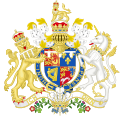
|

|
Frédéric | George II | fils | 1er février 1707 | 11 juin 1727 | 8 janvier 1729[3] | / | 31 mars 1751 |

|
|

|
George futur George III |
petit-fils | 4 juin 1738 | 31 mars 1751 | 20 avril 1751[3] | / | 25 octobre 1760 accède au trône |
29 janvier 1820 |

|
|

|
George futur George IV |
George III | fils | 12 août 1762 | 19 août 1762[3] | / | 29 janvier 1820 accède au trône |
26 juin 1830 |

|
|

|
Albert-Édouard futur Édouard VII |
Victoria | fils | 9 novembre 1841 | 8 décembre 1841[3] | / | 22 janvier 1901 accède au trône |
6 mai 1910 |

|
|
Maison de Saxe-Cobourg-Gotha, puis Windsor (depuis 1901)[4]
| Portrait | Nom | Monarque | Parenté avec le monarque | Naissance | Devient héritier | Créé prince de Galles | Investiture | Cesse d'être prince de Galles | Mort | Armoiries |
|---|---|---|---|---|---|---|---|---|---|---|

|
George futur George V |
Édouard VII | fils | 3 juin 1865 | 22 janvier 1901 | 9 novembre 1901[3] | / | 6 mai 1910 accède au trône |
20 janvier 1936 |
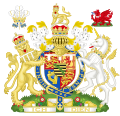
|
|
Édouard futur Édouard VIII |
George V | fils | 23 juin 1894 | 6 mai 1910 | 23 juin 1910[3] | 13 juillet 1911 | 20 janvier 1936 accède au trône |
28 mai 1972 |

|
|

|
Charles futur Charles III |
Élisabeth II | fils | 14 novembre 1948 | 6 février 1952 | 26 juillet 1958[3] | 1er juillet 1969 | 8 septembre 2022 accède au trône |

|
|

|
William | Charles III | fils | À venir | en fonction |

|
Princesses de Galles
L'épouse du prince de Galles est appelée princesse de Galles, et elle reçoit comme son mari le prédicat d'altesse royale. La seconde épouse du prince Charles, Camilla, bien qu'officiellement princesse de Galles, n'utilisait pas ce titre par respect pour sa première épouse, Diana, à qui le titre est fortement associé par le public, mais celui de duchesse de Cornouailles, et de duchesse de Rothesay en Écosse. Le titre est attribué le 9 septembre 2022 à Catherine de Cambridge, dite Kate Middleton, à la suite de son mari, héritier du trône.
Notes et références
- (en) Laura Elston, « How the royal family’s titles have now changed after the death of the Queen », sur The Independent, (consulté le ).
- Raymond Petit et Adrien Lerou, Le Ponthieu et la dynastie anglaise, Société d'émulation d'Abbeville, 1969.
- l Previous Princes
- En 1917, le sentiment anti-allemand parmi la population britannique pendant la Première Guerre mondiale conduit la famille royale à changer tous ses titres et noms de famille à consonance allemande pour des titres et des noms à consonance anglaise. La maison et la famille royales sont ainsi rebaptisées Windsor par un décret en conseil du roi George V.
Annexes
Articles connexes
- Duc de Cornouailles
- Duc de Rothesay
- Grand Steward d'Écosse
- Liste des héritiers du trône britannique
- Ordre de succession pour le trône britannique
Liens externes
- Site officiel
-
Ressource relative aux beaux-arts :
- (en) British Museum
-
Notice dans un dictionnaire ou une encyclopédie généraliste :
Médias utilisés sur cette page
Auteur/Créateur: Manjiro5, Licence: CC0
Icône des homonymies sur Wikipédia francophone
Edward of Westminster, son of King Henry VI.
Auteur/Créateur:
- File:Coat of Arms of the Prince of Wales (Modern).svg: Sodacan
- travail dérivé Sodacan
'’’Coat of Arms of the Princes of Wales’’’ with France Modern
Auteur/Créateur: Sodacan, Licence: CC BY-SA 3.0
Ostrich feather Badge of the Prince of Wales
Auteur/Créateur: Jan Haug, Licence: CC BY 3.0
Haakon, Crown Prince of Norway.
Auteur/Créateur: Pbroks13 (talk), Licence: CC BY 3.0
Crown of the French King
Auteur/Créateur: Bundesministerium für Europa, Integration und Äußeres, Licence: CC BY 2.0
Hereditary Prince Alois of Liechtenstein meets the Austrian foreign minister Karin Kneissl in Vaduz on 15 November 2018.
George V
Auteur/Créateur: User:Huhsunqu, Licence: CC BY-SA 2.5
Image manquante. Une illustration sous licence libre serait la bienvenue. Voyez Comment importer un fichier pour savoir comment importer une de vos photos sur Wikipédia ou Comment insérer une image pour savoir comment mettre une image déjà sur Wikipédia ou Commons dans un article.
Auteur/Créateur: RVD, photographer: Jeroen van der Meyde, Licence: CC0
Wassenaar, najaar 2014: de Prinses van Oranje.
The Prince of Wales (later King Edward VII)(1841-1910)
Auteur/Créateur: Sodacan, Licence: CC BY-SA 3.0
Arms of Edward Prince of Wales, later King Edward II
King Richard II of England (1367 - 1400). Head of the famous portrait shown in Westminster Abbey, London, where Richard is buried. It is the work of an unknown master, and the date is usually given as about 1390. This painting is the earliest known portrait of an English monarch, according to the Abbey's website.
Auteur/Créateur: Sodacan, Licence: CC BY-SA 3.0
’’’Coat of arms of Albert 'Bertie' Edward, the Prince of Wales’’’ later King Edward VII (Albert Edward; 9 November 1841 – 6 May 1910) was King of the United Kingdom of Great Britain and Ireland and Emperor of India from 22 January 1901 until his death in 1910. The eldest son of Queen Victoria and Prince Albert of Saxe-Coburg and Gotha. Before his accession to the throne, he was heir apparent and held the title of Prince of Wales for longer than any of his predecessors. He was heir to the Duchy of Saxe-Coburg and Gotha until before his marriage when he renounced his right to the succession, which then devolved to his younger brother Alfred, Duke of Saxe-Coburg and Gotha, as their parents had intended. His arms until that time displayed an inescutcheon of the Kingdom of Saxony.
Auteur/Créateur: Sodacan, Licence: CC BY-SA 3.0
Coat of arms of HRH Prince William, the Prince of Wales (born 1982) son of King Charles III and Diana, Princess of Wales. The coat of arms was granted in 2022 to him as the Heir-Apparent to the British and Commonwealth thrones.
| “ | Quarterly, 1st and 4th Gules three lions passant guardant in pale Or armed and langued Azure (for England), 2nd quarter Or a lion rampant within a double tressure flory-counter-flory Gules (for Scotland), 3rd quarter Azure a harp Or stringed Argent (for Ireland), with over all a label of three points Argent, and on an inescutcheon ensigned by the coronet of the heir-apparent, quarterly, Or and Gules four lions passant guardant counterchanged (for the Principality of Wales), the whole surrounded by the Garter; for a Crest, upon the Royal helm the coronet of his degree Proper, thereon a lion statant guardant Or crowned by a coronet of his degree Proper; Mantling Or and ermine; for Supporters, dexter a lion rampant guardant Or crowned as the Crest and charged on the shoulder with a label as in the arms, sinister a unicorn Argent armed, crined and unguled Proper, gorged with a coronet Or composed of crosses patée and fleurs de lys a chain affixed thereto passing between the forelegs and reflexed over the back also Or and charged on the shoulder with a label as in the arms; Motto ‘Ich Dien' in the compartment below the shield two badges, a plume of three ostrich feathers Argent enfiled by a royal coronet Or also with the motto ‘Ich Dien’’, and on a mount Vert, a dragon passant wings elevated Gules charged on the shoulder with a label of three points Argent. | ” |
George, Prince of Wales (1738-1820)
- pastel on vellum
- 40.6 x 29.8 cm
- 1754
Auteur/Créateur: Charlot B, Licence: CC BY-SA 4.0
Princess Elisabeth, Duchess of Brabant on 21 July 2017
Auteur/Créateur: Frankie Fouganthin, Licence: CC BY-SA 3.0
Guillaume, Grand-Duc Héritier de Luxembourg sur le chemin de l'église du château au palais royal à Stockholm avant le mariage de la princesse Madeleine avec Christopher O'Neill 8 Juin 2013.
George IV of the United Kingdom as the Prince Regent, circa 1814. He served as king of the United Kingdom of Great Britain and Ireland from 1820 to 1830. The Regency, George's nine-year tenure as Prince Regent, which commenced in 1811 and ended with George III's death in 1820, was marked by victory in the Napoleonic Wars in Europe.
----
George IV of the United Kingdom (1762-1830), Regent 1811-20; reigned 1820-30. Oil on canvas, 36 in. x 28 in. (914 mm x 711 mm), purchased, 1861, on display in Room 17 at the National Portrait Gallery.
Artist: (quoted from the National Portrait Gallery)
Sir Thomas Lawrence (1769-1830), Portrait painter, collector and President of the Royal Academy. Artist associated with 425 portraits, Sitter in 13 portraits.
In 1814, Lord Stewart, who had been appointed ambassador in Vienna and was a previous client of Thomas Lawrence, wanted to commission a portrait by him of the Prince Regent (later King George IV). He therefore arranged that Lawrence should be presented to the Prince Regent at a levée. Soon after, the Prince visited Lawrence at his studio in Russell Square. Lawrence wrote to his brother that To crown this honour, [he] engag'd to sit to me at one today and after a successful sitting of two hours, has just left me and comes again tomorrow and the next day. The result was a drawing in the Royal Collection, this dashing oil sketch of his head in profile like a Classical god and a large portrait of him in Field Marshall's uniform.
Auteur/Créateur: Saeima, Licence: CC BY-SA 2.0
December 6, 2018. Speaker of the Saeima Ināra Mūrniece receives Crown Prince Frederik of Denmark and Crown Princess Mary in the parliament.
Photo: Ernests Dinka, Saeima
Terms of use: saeima.lv/lv/autortiesibasAuteur/Créateur: Sodacan, Licence: CC BY-SA 3.0
Coat of arms of Edward, the Prince of Wales later King Edward VIII.
(c) Bundesarchiv, Bild 102-13538 / CC-BY-SA 3.0
Edward, Prince of Wales, son of King Richard III and his Queen consort, Anne Neville. Cropped portion of, Richard III and family in the contemporary Rous Roll in the Heralds' College.
Auteur/Créateur: Sodacan, Licence: CC BY-SA 3.0
’’’Coat of arms of George, the Prince of Wales’’’ later King George V.
Auteur/Créateur:
- File:Coat of Arms of the Prince of Wales (Ancient).svg: Sodacan
- travail dérivé Sodacan
'’’Coat of Arms of the Princes of Wales’’’ with France Ancient
Auteur/Créateur: Sodacan, Licence: CC BY-SA 3.0
’’’Coat of arms of the Hanoverian Princes of Wales’’’ used by George II, Frederick and George III.
Edward I creating his son, the later Edward II, prince of Wales, 1301. Text reads "Eduuardus factus est princeps Wallie" (Edward is made prince of Wales).
Auteur/Créateur: Sodacan, Licence: CC BY-SA 3.0
’’’Coat of arms of George, the Prince of Wales and Prince Regent’’’ later King George IV.
Auteur/Créateur: Royal Navy, Licence: OGL 3
Prince William visiting a Royal Navy facility in June 2021.
Auteur/Créateur: Dean Calma / IAEA, Licence: CC BY 2.0
Bilateral meeting between IAEA Director General Yukiya Amano and HRH Crown Princess Victoria of Sweden during the Ministerial Conference on Nuclear Science and Technology: Addressing Current and Emerging Development Challenges, at the Agency headquarters in Vienna, Austria.
Auteur/Créateur: Sodacan, Licence: CC BY-SA 3.0
Coat of arms of the Stuart Princes of Wales used by Henry Stuart, Charles I, Charles II and James Francis Edward Stuart (the Old Pretender).
Shields of Henry Stuart and Charles II are described in Ashmole, Elias (1715) The History of the Most Noble Order of the Garter, London: Bell, Taylor, Baker, and Collins, pages 531, 534Auteur/Créateur: Sodacan, Licence: CC BY-SA 3.0
Ostrich feather Badge of the Prince of Wales
Arthur, Prince of Wales (1486-1502), wearing a collar composed of red and white Tudor roses and hat with a hat badge bearing the figure of St John the Baptist and two rosette-shaped cap hooks.
Portrait of Prince James Francis Edward Stuart
George II when Prince of Wales



